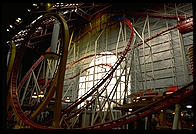
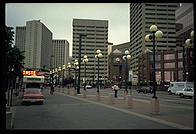 Monday, June 28
Monday, June 28
After being tortured by America OnLine, the finest flower of 1990s corporate computer technology, it was a joy to use Internet, the bastard child of the spare hours of underfed computer science graduate students. Because Internet is free, people tend to be generous with network hospitality and the University of Alberta computer science department was no exception.
I settled into a machine vision laboratory with a couple of young women from mainland China. Dozens of messages were waiting for me at MIT that America OnLine had lost! My friends hadn't forgotten me after all. I spent the whole day responding to friends, posting questions on bulletin boards, refining chapters of this book, and printing.
The fabled West Edmonton Mall was but a pale shadow of the Mall of
America. Built in three phases, it is more a haphazardly connected
group of unrelated buildings than one coherent structure. Just being
inside was disorienting even when one's local surroundings were pleasant
and familiar. It is allegedly slightly bigger than Mall of America,
with 16,000 employees and a quarter of a million shoppers on a peak
day.
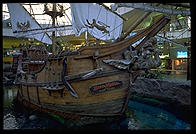
There are three nonstandard attractions in the mall. The first is a theme park with a frightening rollercoaster. It looks much more violent than Space Mountain and throws people through standard and twisting loops multiple times. The second attraction is an intricately tangled collection of waterslides. The third is a submarine ride complete with a Kodak-funded replica of the Santa Maria. The variety of shops seems a bit greater than in Mall of America; I managed to buy Plato's Symposium dialogue, which had eluded me in bookstores spread across 2,000 miles.
"May I please have a $3.50 frozen yogurt and an ice water?" I asked a taciturn middle-aged woman. She gave me the yogurt, took my money, then refused to give me the ice water.
"You have to buy an Evian. Two dollars," she grunted.
I wanted to throttle her, but I reflected that it would have confirmed the American reputation for violence.
Edmonton was an easy place to leave--"Houston without the charm" is how I took to describing it. Laissez-faire zoning plants skyscraper next to vacant lot next to two-story shabby hotel next to four-story Canadian downtown mall. Calgary is definitely Alberta's class act. Edmonton is so ugly that people are apparently discouraged from taking photographs: despite having roughly the same population, Edmonton does not have the high quality photolabs that Calgary has.
Perhaps people, when confronted by ugliness for long enough, eventually learn to close their eyes. They avoid being horrified but are forever after blind to beauty as well. Thus an art historian from Edmonton can't appreciate a Vermeer as well as an accountant from Paris. Just walking around the streets of Paris for a lifetime has built up in the accountant a capacity for aesthetics.
I hit the road at 10:00 PM for an eerie drive northwest through the prairie. Even at 2:00 AM the northern part of the sky never really got dark. When I was finally ready to sleep, I just pitched my tent by the edge of desolate Sturgeon Lake and collapsed.
Tuesday, June 29
Grande Prairie's Leisure Center was nearly a clone of the lovely aquatic center at Jasper: big Jacuzzi, water slide, and warmish training pool. The coin-operated lockers were exactly the same design as in every other swimming pool in Canada and I began to get some of the same "small country" feeling that I'd had in New Zealand. In the U.S. there is such a plethora of products that one never gets used to any one design.
In Main Street, prosperous farmers and merchants in Gopher Prairie, Minnesota, often up and move to Alberta to build a life exactly like the one they'd left behind. That was in 1912. Lewis might have been on to something:
"Grande Prairie has Tremendous Potential" -- slick 1993 visitor's guideGrande Prairie's indifferent architecture and city planning would have outraged and depressed Carol Kennicott. The two downtown streets have been made one-way so that cars might better roar through. "Downtown" is a collection of one-story shacks housing nondescript shops. The one building that stands out is an absurdly huge 14-story black glass monolith whose owners were too embarrassed even to stick their name on the top.
"Watch Gopher Prairie Grow" -- opening slogan for James Blasseur's "boosting" campaign in Main Street
Even if all the residents of Grande Prairie have had their aesthetic senses assaulted, their hospitality remains intact. Shelly, a young mother, noticed my Massachusetts plates and stopped her truck to chat. She'd just been laid off from her job at Safeway and was delighted to be collecting Canadian unemployment while her husband worked. She'd never been to Alaska herself and spoke a bit regretfully about the reduction in free time imposed by her two daughters. Shelly encouraged me to pursue my dreams and live life a little differently: "Too many people get stuck in a rut and never do anything interesting."
At Mike's Lube & Clean, where I had the Caravan's oil changed (6800 miles), a burly mechanic suggested I go to the Pepperpot Cafe where I could get a "nice quiche and salad." I'd listened to the occasional Canadian try to distinguish Canadian culture from American, but kept thinking that both countries are the product of English middle-class culture spread out into a vast wilderness. Even if the U.S. and Canada had been established on separate planets and there were no cross-border influences, they might look similar to an outsider.
Kameel Nasr's The World Up Close provided lunchtime reading and a perspective on this issue. Nasr chronicles his adventures as a lone cyclist in places that are truly different from North America: Tanzania, where people would rather wade through mud for a lifetime than spend an afternoon throwing together a dock; Morocco, where hashish merchants formed human chains across the road to force Nasr to stop and buy their wares.
Nasr's list of good countries to visit: the U.S. because you can get a free bed and dinner every night just by asking nice; France because, well, it's France; Italy because of the bike racing culture; Nicaragua under the Sandanistas because it is a utopian paradise despite U.S. oppression and the only Latin American country where officials don't demand bribes; Algeria because it feels damned peaceful after one has been assaulted by merchants in Morocco; Egypt because of the Bedouin hospitality and despite drivers' bizarre habit of blowing their horns nonstop.
Countries to skip: the U.S. because it has too many mountains; Germany because 12-year-old boys will yell at you for breaches of etiquette; Israel because people are rude to everyone and suspicious in particular of a Palestinian-American cyclist/author; Yugoslavia because people there make Israelis look positively polite; India because it is too hot and disease-ridden; non-Nicaraguan Latin America because people have been turned into bribe-taking impoverished despairing malcontents by U.S. oppression; China because it is easy to get lost using a Mandarin phrase book to tour Canton.
The road from Grande Prairie to Dawson Creek, Mile 0 on the Alaska Highway, rolled through fields of brilliant yellow blossoming canola seed (née rape seed but renamed CANada OiL seed by some advertising genius). Once in Dawson Creek, I joined the fleet of motor homes at the Alaska Highway Museum and absorbed the story of the highway from an old film.
Work on the highway began just four months after the Japanese attacked
Pearl Harbor. Pentagon strategists decided that the next logical
Japanese move would be to invade Alaska: "Whoever controls the
Aleutians controls the Pacific." Before obtaining Canadian consent,
the project was announced in Washington and troops were sent to
Canada. Two weeks later, the Canadian prime minister announced his
government's approval of the project without alluding to the Americans
jumping the gun.
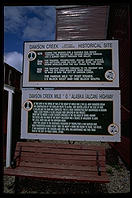
At this spot in the spring of 1942 at the height of WWII, the U.S. Army engineers began the construction of the overland route to Alaska. Nine months later at the cost of over $140,000,000 the road was completed. This is a road construction feat unsurpassed in modern times. 11,000 troops and 16,000 civilians were employed in this project.Now we could move men and materiel up to defend Alaska should the need arise (or evacuate the defeated and terrorized populace in case things didn't go our way). According to the film, two hundred people died building the road but urban geeks learned to fish and hand-feed bears, so it wasn't all for naught.
There are 133 briges [sic] & 8000 culverts embodied in the 1523 miles of gravel highway. The rattle and roar of the mighty bulldozer was a source of amazement to both the local white man and the northern Indian.
Over this lifeline to the Northwest, thousands of troops, food & war supplies have been transported. In more recent times, the mighty H-bomb was known to travel this route. It was maintained by the Canadian Army until April, 1964. Maintenance was then taken over by the Dept. of Public Works, Ottawa.
--- sign in front of Alaska Highway Museum
Six months after Pearl Harbor, the Japanese in fact invaded the Aleutian Islands, hoping to establish a supply/staging base there. Thanks to valiant American/Canadian resistance, the Japanese were repulsed and we were able instead to use the Aleutians as an air base for the first bombing attacks on Tokyo (ultimately bombed so badly that proponents of dropping the first A-bomb there were forced to concede that it wouldn't do much additional damage).
Throughout the War, the highway was continuously improved although never paved. American salesmanship convinced the Canadian Army to buy the road in 1946 for $77 million. Tired of maintaining the gravel road, the army tried to give it away to the province but they wouldn't take it until 1962. By the 1970s enough motor homes were making the run that somebody got the brilliant idea of paving the road and now it is mostly paved.
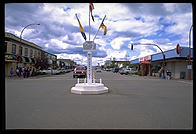 Fortified with information and snapshots of the Mile 0 milepost, I
struck out through farms and then some of the most boring scenery of
the trip so far, vaguely reminiscent of northern Minnesota. Although
distant mountains are sometimes visible, the forest on both
sides of the road has been brutally clear-cut and indifferently
replanted. One gets a palpable feeling of the rape of the
wilderness.
Fortified with information and snapshots of the Mile 0 milepost, I
struck out through farms and then some of the most boring scenery of
the trip so far, vaguely reminiscent of northern Minnesota. Although
distant mountains are sometimes visible, the forest on both
sides of the road has been brutally clear-cut and indifferently
replanted. One gets a palpable feeling of the rape of the
wilderness.

A few hours on the Highway is sufficient to see that the local economy is based on delivery of three services: windshield repair, tire repair, and (most worrisome) welding. I expected to need the first, doubted I'd need the second, and prayed I wouldn't need the third. Most of the first 300 miles is pretty well surfaced. What is paved is in better condition than most Cambridge streets; only a few short sections of gravel surface have punishing potholes.
Once in the "town" of Fort Nelson, I hung out with Samantha at Dan's Neighbourhood Pub. It is strange at night to walk from the bright light of the outdoors into a dim bar. One usually associates civilization with light, but in the summer here darkness is an exclusive product of civilization. Marcy, the bartender, was a lifelong Fort Nelson resident who'd been away only to study biology at Vancouver's U.B.C. Marcy planned on graduate school, although not at MIT. Why not? She'd never heard of MIT. I'd expected the "people of the Alaska Highway" to be solid hardy pioneers, but Marcy was very delicately constructed with a slight build, dark hair, and pale skin.
Kelly, a compact 28-year-old with an open face and a shock of brown hair, born and raised in Grande Prairie, looked over my shoulder as I wrote a rather vicious account of his hometown. This drummer/miner/Pepsi-merchandiser had lived in Vancouver for five years and supported himself as a freelance drummer.
"I shared an apartment with a cute blonde older girlfriend until I introduced her to her husband. Breaking up with Breean didn't drive me out of the city; I moved when it became `Hongcouver.'"
Kelly invited me to join him in his Pepsi-funded motel room in town and I did, acquiring my very own double bed for the first time since East Glacier. Paradoxically, I didn't sleep all that well. Kelly and I stayed up talking until 2:00 AM. He spoke about sharing a house in Grande Prairie (only $65,000 Cdn!) with his girlfriend of six years and of the struggle to remain faithful to her in spite of temptation.
"Women just throw themselves at me after concerts. They don't care if a guy has a bad character as long as he is a musician. I don't have too much trouble resisting, though. Sex for the sake of sex isn't as important to me as when I was 17."
We were about to drift off when Kelly asked a disarming question.
"Why would anyone call himself `Jewish' and not `Christian.'"
Mechanically, I said that I supposed it was because there were people who accepted the Hebrew Bible but not the New Testament, nor that the Messiah was Jesus, nor any of the 50-odd other "would-be Messiahs" of the last 2500 years.
"Oh," said Kelly, with a look indicating he shared my belief that this wasn't much of an answer. "I've never met any Jews before. It seems kind of odd that someone would accept only half of the Bible. I'm not much of a churchgoer myself, but I was raised Baptist in Grande Prairie."
Kelly talked about how the choices one makes early in life inexorably determine one's position at retirement. He estimates only about 3% of folks are able to reach Paradiso, i.e., "cruising up the highway in a motor home with plenty of money for gas."
Kelly's Inferno?
"Sharing a bus with 60 other smelly people."
June 30
Kelly left early in the morning and I found myself unable to sleep but also unable to face the gray rain. I lay in bed and read The Symposium from start to finish. I won't presume to summarize Socrates and friends, but the part that I like best is Aristophanes explaining homosexuality versus heterosexuality. Originally, people did not go about singly, but were physically joined together with another person. There were male-male, female-female, and male-female combinations. You had four legs, four arms, two faces, etc., and when you wanted to move fast you did it by cartwheeling. The Gods became angry with Man at one point and split all of these couples up, taking the extra skin and making belly buttons. People now wandered around desperately lonely looking for their old partners.
If you are a woman seeking women, you were originally intended to be part of a female-female pair; if you seek someone of the opposite sex, you were originally intended to be part of a male-female pair; if you are a man seeking a man (the most praiseworthy kind of person), you must have originally been intended to be part of a male-male pair. People who find the exact person for whom they were originally intended happily remain with that person for a lifetime; people who don't continue to search. Aristophanes cautions us to worship the gods carefully; if they get angry again they'll split us all in half and we'll have to hop about on one leg.
My shower fogged up the mirror enough to reveal a message in soap: "It was fun to meet you, Philip. Have a great trip, Your friend, Kelly."
After filling the car for a shocking $40 Cdn., I continued north. The
highway quickly disintegrated into long gravel sections littered with
potholes. Oncoming vehicles were few, but most materialized out of
the rain as huge trucks spraying gravel at my windshield. For three
hours, I passed more clearcut forests, climbed over a small mountain
range, and spent a long time next to a river meandering through fields
of rock left behind from the time a mighty glacier had flowed in the
valley. Large collections of trees ripped out upstream littered the
sides of all the channels.
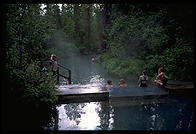
At Liard Hot Springs, I soaked in the 104-109 degree mildly sulfurous water. Most of the soakers were stereotypical Canadian motor home drivers, retired guys with pale skin and big guts hanging over their swimsuits. I chatted with Sallie, a young Coloradan mother and her perfect 10-year-old son Ben. Seeing the mountains of the North has been her dream for years, but this is the first time she has managed to get away from her word-processing job. She left her second husband behind painting houses while she and Ben roam.
Sallie invited me to a turkey hotdog roast at her campsite. Proving Rousseau's point that civilized man is inferior to the American Indian, we couldn't get a proper fire started even though we sacrificed both the Alberta campground guide and the Montana lodging guides. Seeing Sallie and Ben together made me think how much fun it would be to have a child along on this trip. On the other hand, I was probably romanticizing the experience of showing a child the wonders of the world; most of the actual parents I'd met on the trip were a touch shell-shocked.
At about 8:30 I pressed on up the highway, continuing until 11:15 when I felt dead tired. I camped next to a creek and rushed to put up my tent before the mosquitoes ate me alive. After 6000 mosquito-free miles, they'd suddenly come out with a vengeance.
Thursday, July 1 (Canada Day)
Trying to drive and kill the 15 mosquitoes that had entered the van
at the same time was a challenge, but I managed somehow and spent an
uneventful hour and a half driving under grey skies.
"Park the vehicle on a firm and level surface." -- Dodge Caravan Owner's ManualThe last place that fit this description was 400 miles back in Dawson Creek. My inspiration for reading started at 60 mph with a peculiar sound and a pronounced desire on the part of my minivan to exit the highway to the right. I managed to keep the car on the road and braked lightly to a stop with the car 25% off the road.
My right front tire was completely flat. The shoulder, as along so much of the Alaska Highway, consisted of a 20-foot-deep ditch. Traffic was pretty light, but mostly huge motor homes, tandem semi-trailers, and flatbeds hauling oversized mobile homes. Hills front and back prevented anyone from seeing me.
I'd no alternative but to drive on the rim until a better tire-changing spot could be found. I drove about one quarter mile to a spot with a wider shoulder and better views for traffic, but still was only able to get the car 50% off the road.
Task #1: get the spare tire out from under the car.
It was easy enough to winch down from the chassis, but there was no way to slide it out from under the car. The spare was hemmed in on all sides by the rear tires, the exhaust system, and the trailer hitch. I considered jacking up the driver's rear side of the car, but didn't relish operating a scissors jack smack in the middle of the Alaska Highway. At this point I congratulated myself on having made my will just before leaving Boston. Taking all 500 lb. of junk out of the car lifted the trailer hitch enough that I was able to drag the spare out.
Task #2: figure out if it would be possible to jack the car.
The highway here is dramatically crowned and the shoulder drops down at a 10 degree angle at least. The only way to level the car would in fact be to park it directly over the yellow centerline, so "level" was out of the question. "Firm" was not an adjective that one would normally apply to the dirt-and-gravel shoulder, but I didn't think towing the car 30 miles to the nearest gas station was an option.
Keeping first the spare and then the flat tire under the rocker
panel--in case the car fell off the jack, it would theoretically come to
rest on the spare wheel rather than on the brake rotor--I managed to
jack the car with a minimum of trepidation.
"And I will cast abominable filth upon thee, and make thee vile, and will set thee as a gazingstock."By the time I'd finished changing the tire, I was covered in black or brown filth from head to toe. As the exterior of the car was so encrusted in mud that the license plate was no longer readable, it should have come as no surprise that the stored-under-the-car spare was thoroughly filthy. Nonetheless, I couldn't believe the sorry state of my clothing and the dirt under my fingernails.
-- Nahum 3:6
Changing the tire wasn't the best hour of my trip, but I did get something positive out of it: the knowledge that, Kitty Genovese notwithstanding, Real North Americans won't abandon their fellow human being to his fate. At least half of the passersby stopped to offer assistance, including two women traveling with two babies in car seats (being a true gentleman, I naturally didn't deprive them of the opportunity to get some "hands-on" experience with a lug wrench). A pyramidally corpulent Maine couple stopped in their motor home, and we had a pleasant time recalling our last meeting in a North Dakota gas station. Even during long intervals between trucks, I wasn't lonely; crowds of mosquitoes and a few wasps gathered to observe and assist.
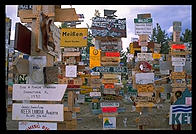 When I got to Watson Lake, I managed to get what looked like a nail hole
in the tread fixed for a mere $13 Cdn. but was disappointed to find the
swimming pool closed for Canada Day. I showered at a gas
station/laundromat/cafe/showers (a very common combination up here) and
was never so glad to be clean again. Watson Lake is the first town in
the Yukon Territory, a region the size of California with a population
of 30,000. Canadian territories have as much power to make their own
laws as provinces. The principal difference is that territories aren't
required to fund their own operations to the same extent as
provinces.
When I got to Watson Lake, I managed to get what looked like a nail hole
in the tread fixed for a mere $13 Cdn. but was disappointed to find the
swimming pool closed for Canada Day. I showered at a gas
station/laundromat/cafe/showers (a very common combination up here) and
was never so glad to be clean again. Watson Lake is the first town in
the Yukon Territory, a region the size of California with a population
of 30,000. Canadian territories have as much power to make their own
laws as provinces. The principal difference is that territories aren't
required to fund their own operations to the same extent as
provinces.
Canada Day is yet another distinction without a difference. They could have picked July 4 to celebrate their independence but, instead, in 1867 Canadians picked July 1. It makes cross-border travel gratuitously confusing. Whatever the date, the celebration is the same as in the U.S.: barbecuing mysterious parts of dead animals, inane diversions for children, hiding from thundershowers under tarps at picnics, and drunk driving. I crashed the town's mass picnic and gulped down a hot dog under a tarp but didn't manage to strike up any conversations with the distracted parents and soaked adolescents in attendance.
Three hours of driving through sometimes torrential rain brought me to a cafe just east of Teslin, Yukon. After driving past one rat shack gas station/cafe/motel after another, it was a relief to see some warm and tasteful natural wood architecture. Dave and Carolyn preside over this oasis. Dave has lived here for 20 years, spending the winters teaching all grades (7-9), all subjects, and all twenty students in Teslin Junior Hall.
"They are mostly Native and unfortunately more inclined to alcohol than academics," Dave sighed as I ate superb baked-fresh-by-Carolyn rhubarb pie and ice cream. I was much more upset by his next bit of information.
"This is the worst summer for mosquitoes in history, all over the Yukon and Alaska. Getting out of a vehicle in Denali National Park right now is tantamount to suicide."